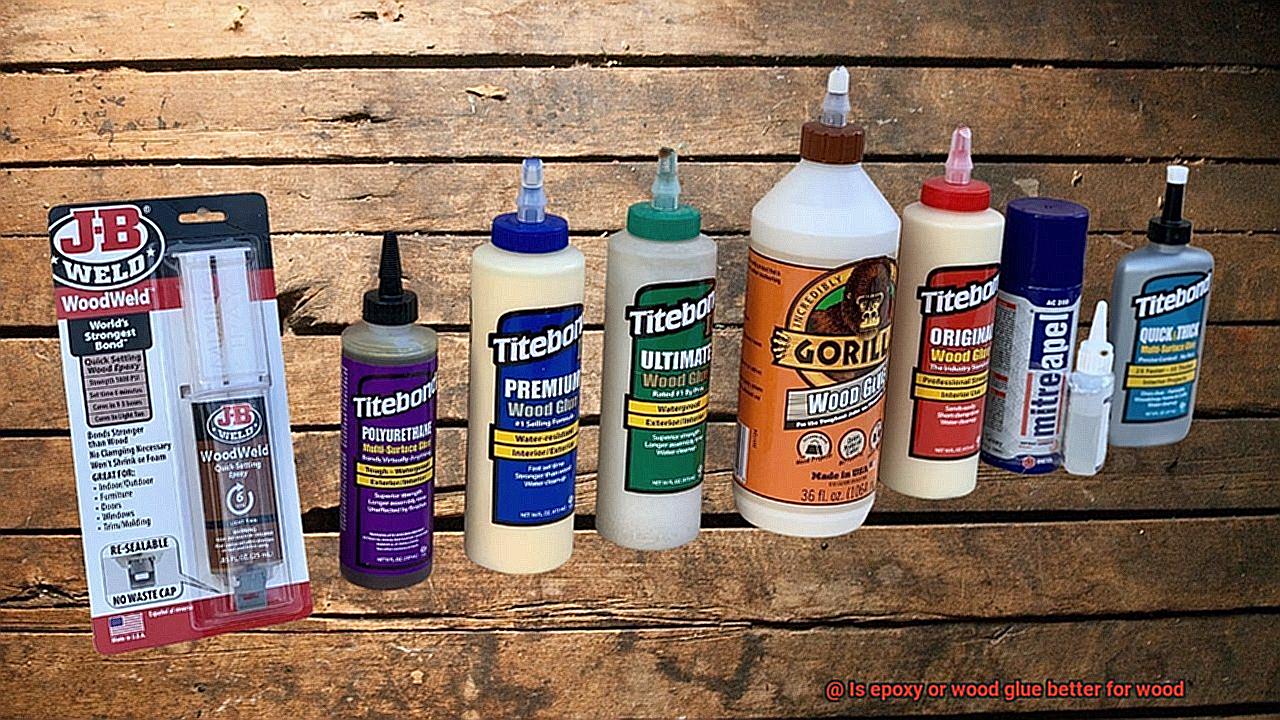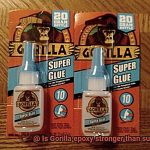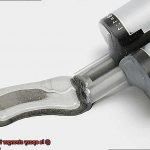Have you ever found yourself in a sticky situation, trying to choose between epoxy or wood glue to repair your wooden object? It can be overwhelming to decide which adhesive is best suited for the job at hand. But fear not, because both epoxy and wood glue have their unique benefits and drawbacks, catering to specific needs and environments.
Epoxy and wood glue are two of the most versatile adhesives for woodworking projects. They offer fast, permanent bonds that are essential for any DIY enthusiast. However, choosing the right one depends on your project’s specific requirements.
Epoxy has a more rigid texture, making it ideal for tough and demanding jobs. It can bond different materials or fill gaps with unparalleled strength. Epoxy is also waterproof, heat-resistant, and works in extreme temperatures.
Wood glue, on the other hand, is an adhesive made solely for bonding wood. This glue is easy to use, dries quickly and creates a strong, long-lasting bond. It appeals to traditionalists who prefer natural materials as it’s mostly made of organic substances.
Now that you know the main differences let’s dive deeper into each adhesive’s strengths, uses, and drawbacks. By doing so, we’ll help you determine which adhesive is better suited for your woodworking project.
What is Epoxy?
Contents
- 1 What is Epoxy?
- 2 What is Wood Glue?
- 3 Advantages of Using Epoxy for Woodworking
- 4 Disadvantages of Using Epoxy for Woodworking
- 5 Advantages of Using Wood Glue for Woodworking
- 6 Disadvantages of Using Wood Glue for Woodworking
- 7 When to Use Epoxy vs Wood Glue for Woodworking Projects
- 8 Tips and Tricks for Working with Epoxy and Wood Glue
- 9 Conclusion
Epoxy is a remarkable adhesive that has earned its reputation as a go-to solution for woodworking projects. It is a two-part adhesive that consists of a resin and hardener, which, when combined, create an incredibly strong and durable bond. Epoxy is prized for its exceptional strength, toughness, and resistance to water and chemicals.
One of the most significant advantages of using epoxy is its ability to bond different types of materials together, including wood, plastic, metal, and glass. This makes it ideal for woodworking projects where multiple materials need to be joined together. Moreover, epoxy can fill gaps and cracks in wood, making it an excellent choice for repairing damaged or rotting wood.
Another advantage of epoxy is its ease of use. The two components are typically mixed together in equal parts and applied to the surfaces to be bonded. The adhesive sets quickly and cures within a few hours, depending on the temperature and humidity of the environment. This makes it a convenient option for woodworking projects that require a quick bond.
However, epoxy does have some drawbacks. It can be more expensive than other types of adhesives, such as wood glue. Additionally, proper handling and adequate ventilation are necessary due to its strong odor and potential health hazards. Epoxy also dries to a hard, glossy finish that may not be suitable for certain woodworking applications.
When deciding whether to use epoxy or wood glue for your woodworking project, consider the specific requirements of the project. If you need a strong and durable bond that will withstand heavy use or stress, epoxy may be the better choice. However, if you need a quick bond or do not require as much strength, wood glue may be the more practical option.
What is Wood Glue?
Wood glue is the superhero of adhesives, designed to bond wood materials and withstand the everyday wear and tear. As a wood glue expert, I can tell you all about this essential tool for any woodworking project.
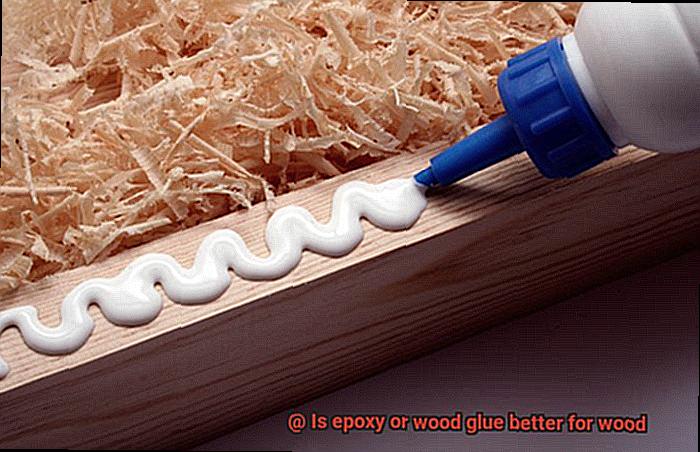
There are several types of wood glue available on the market that cater to different needs. The most widely used wood glue is PVA glue, which is easy to work with and dries clear. Its long working time makes it ideal for projects that require precise placement or alignment. What’s more, PVA glue can be sanded or painted over after it has dried, making it a versatile option.
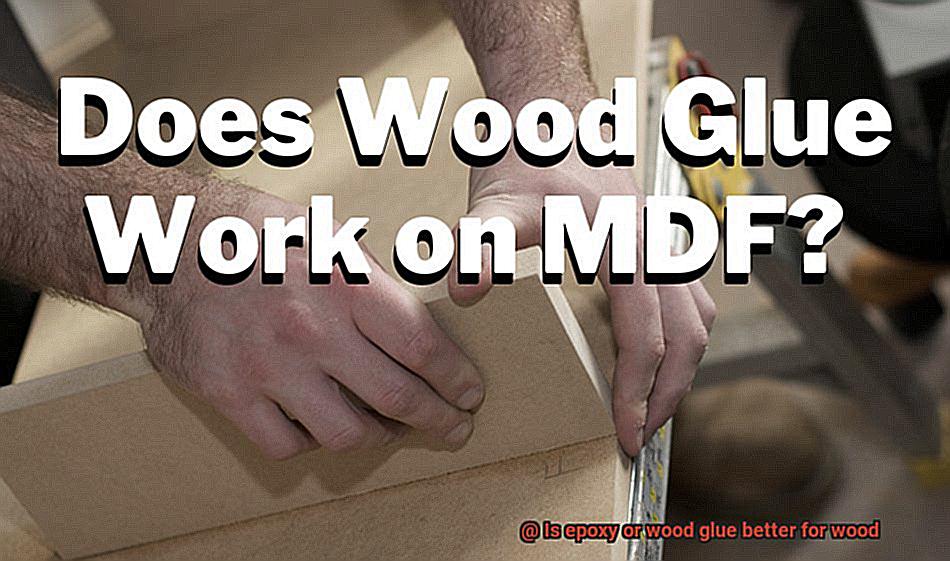
Another popular type of wood glue is liquid hide glue, made from animal hides and used for centuries in woodworking. Liquid hide glue has several advantages over other types of wood glue, including its ability to be easily reversed with heat or moisture and its superior bonding strength.
For a fast-drying adhesive, cyanoacrylate glue, also known as “super glue,” may be the right option for you. However, it’s not recommended for use on large surfaces or for projects that will be subject to heavy stress or strain.
But why use wood glue in the first place? Aside from creating a strong and durable bond, wood glue can also help prevent splitting and cracking in the wood. It fills gaps between pieces of wood for a seamless finish and makes your project look professional.
Advantages of Using Epoxy for Woodworking
It’s time to upgrade to epoxy, the superhero of adhesives. As an expert in woodworking adhesives, I can tell you that epoxy is a game-changer in the woodworking world.
Epoxy is a two-part adhesive that requires mixing before use. Once mixed, it can be applied to the wood and will cure into a strong, durable bond. Here are five advantages of using epoxy for woodworking:
- Stronger Bond: Epoxy has a stronger bond than wood glue, making it ideal for applications where a strong bond is required. Whether you’re building furniture or repairing a broken chair, epoxy can provide the reliable, long-lasting bond you need.
- Water Resistance: Epoxy is water-resistant, making it an excellent choice for outdoor projects or projects that will be exposed to moisture. It can also withstand extreme temperatures, making it perfect for all kinds of weather conditions.
- Gap Filling: Epoxy can fill gaps and cracks in wood, which is especially useful when working with irregularly shaped pieces of wood or when repairing damaged wood. Unlike traditional wood glues, epoxy can fill larger gaps and create a seamless finish.
- Versatility: Epoxy can be tinted or painted to match the color of the wood, making it a versatile adhesive for woodworking projects. You can also use it to create unique finishes or textures on your project.
- Longevity: Epoxy is a durable adhesive that can last for decades without deteriorating or losing its strength. When used properly, it can provide a long-lasting bond that will stand up to years of wear and tear.
Overall, epoxy is a reliable adhesive for woodworking that offers numerous advantages over traditional wood glues. Its strength, water resistance, gap-filling capabilities, versatility, and longevity make it an excellent choice for many woodworking projects.
Disadvantages of Using Epoxy for Woodworking
There are some disadvantages that woodworkers should consider before using it in their projects.
One of the major drawbacks of epoxy is its quick curing time, which can be challenging for woodworkers who need more time to adjust and position their pieces before the adhesive sets. This is especially true for those who are new to woodworking or those who prefer a slower assembly process.
Another downside is the messiness of epoxy. Unlike wood glue, which can be easily cleaned up with a damp cloth, epoxy requires solvents like acetone or rubbing alcohol to remove any excess or spilled adhesive. These solvents can be harsh and potentially harmful if not handled properly.
Furthermore, epoxy is more expensive than wood glue, which could add up quickly for frequent users. Although it offers superior strength and durability, the cost may not be feasible for some woodworkers who are on a tight budget.
Lastly, it is important to note that certain types of wood may not bond well with epoxy. The natural oils or resins in these woods can prevent the epoxy from properly adhering to the surface, resulting in weak joints or even failure. In such cases, wood glue may be a better option for achieving a strong and lasting bond.
Advantages of Using Wood Glue for Woodworking
This type of adhesive offers numerous advantages over other adhesives like epoxy. As an expert in the field, I can confidently say that if you’re looking for an adhesive that provides a strong bond, is easy to use, versatile, and affordable, then wood glue is the best option for your woodworking projects.
One of the most significant advantages of using wood glue is that it creates a bond that is often stronger than the wood itself. This means that your finished product will be incredibly sturdy and durable, able to withstand wear and tear over time. With this type of adhesive at your disposal, you can rest assured that your furniture or decorative items will last for years.
Another great advantage of using wood glue is its ease of use. Unlike other adhesives with a shorter drying time, this type of glue gives you more time to make adjustments to your project before it sets completely. This feature is especially helpful when working on complex designs or intricate projects that require precision.
Wood glue is also highly versatile and can be used on a wide range of materials, including softwoods, hardwoods, MDF, and plywood. Whether you’re building a shelf or designing a wooden toy, wood glue provides the flexibility and strength needed to complete your project with ease. Furthermore, there are different types of wood glue available, such as waterproof and heat-resistant varieties, making it easy to find the best fit for your specific project needs.
And let’s not forget about affordability and accessibility – two essential factors that make wood glue an excellent option for those on a budget. You can find wood glue at most hardware stores or online at a relatively low cost compared to other types of adhesives.
Disadvantages of Using Wood Glue for Woodworking
Wood glue is a go-to adhesive for many woodworkers, but it’s not without its weaknesses. As an expert in woodworking, I’m here to share the disadvantages of using wood glue in your next project.
Firstly, let’s talk about strength. While wood glue can bond two pieces of wood together, it may not be able to withstand the pressure and stress that the finished product may face. This is especially true for furniture and other items that will be exposed to constant use and wear and tear. If you’re building something that needs to be sturdy, consider using a stronger adhesive like epoxy.
Another downside of wood glue is its lack of versatility. It can only be used on porous surfaces, which means it cannot bond non-porous materials such as metal or plastic. This limitation may require you to purchase additional adhesives for different materials, making it less cost-effective.
Moreover, wood glue has a relatively short working time. Once applied, it starts to dry quickly, which means you need to work fast to ensure proper placement before it hardens. This can be challenging for larger projects that require more time and attention, and it might cause mistakes that will affect the final product.
Lastly, wood glue has a tendency to expand during the drying process. This can lead to excess glue seeping out from the joints and creating a messy finish. The excess glue needs to be removed before applying any stain or varnish, making sanding and finishing more difficult and time-consuming.
When to Use Epoxy vs Wood Glue for Woodworking Projects
Making the right adhesive choice is essential for achieving a perfect final product.
Epoxy is a two-part adhesive known for its strength and durability, making it ideal for applications that require a strong bond. It consists of a resin and hardener that are mixed together before application. Epoxy is perfect for boat building or furniture repair, as it can withstand heavy use and exposure to moisture. It is also waterproof, making it an excellent choice for outdoor projects.
Wood glue, on the other hand, is specifically designed for bonding wood and comes in several varieties. The most commonly used type of wood glue is PVA glue, which dries clear and is easy to sand. Wood glue is perfect for applications where appearance is important and only a moderate level of strength is required.
So, when should you use epoxy vs wood glue? Here are some guidelines:
When to Use Epoxy:
- When you require a strong bond that can withstand heavy use or exposure to moisture.
- When you are working on an outdoor project or something that will be exposed to the elements.
- When repairing something that requires maximum strength.
When to Use Wood Glue:
- When appearance is important as it dries clear and can be sanded easily.
- When working with wood and only a moderate level of strength is required.
Tips and Tricks for Working with Epoxy and Wood Glue
When it comes to woodworking, choosing the right adhesive can make all the difference in the success of your project. Epoxy and wood glue are two popular options, each with their own unique characteristics.
Epoxy is known for its incredible strength and durability, making it a great choice for projects that require a permanent bond. However, it can be a bit more challenging to work with than wood glue, as it requires mixing two components together before application. The mixing process must be done thoroughly and evenly to ensure a strong bond.
Wood glue, on the other hand, is generally easier to work with and can be a good choice for projects that require a temporary bond or where clamping time is limited. It’s also more forgiving than epoxy in terms of application, as it can be easily cleaned up with water while still wet.
Regardless of which adhesive you choose, there are some tips and tricks you can follow to ensure successful application.
Preparation is key
Before applying any adhesive, make sure to properly prepare the surfaces you’ll be bonding by cleaning them thoroughly and sanding them if necessary. This will help create a strong bond between the two pieces.
Use the right amount of adhesive
Applying too much adhesive can actually weaken the bond over time by creating excess moisture. Use just enough adhesive to create a thin layer between the two surfaces.
Clamp your pieces together
Regardless of which adhesive you’re using, clamping your pieces together while the adhesive dries can help ensure a strong bond. Make sure your clamps are tight enough to hold the pieces firmly together without causing any damage.
Allow sufficient curing time
It’s important to allow sufficient time for the adhesive to cure before handling or using the bonded item. This can vary depending on the type of adhesive and environmental factors such as temperature and humidity.
Clean up excess adhesive
Once you’ve applied your adhesive and clamped your pieces together, check for any excess adhesive that may have squeezed out. Use a damp cloth to wipe away any excess adhesive before it dries.
Conclusion
To wrap things up, deciding between epoxy and wood glue for woodworking projects can be a daunting task. Each adhesive offers a unique set of advantages and disadvantages that cater to specific needs and environments. Epoxy boasts impressive strength, durability, water resistance, gap-filling capabilities, versatility, and longevity. While wood glue is specifically formulated for bonding wood and provides a bond that’s often stronger than the wood itself. It’s affordable, easy to use, versatile, and comes in several varieties.
When selecting an adhesive for your woodworking project, it’s important to consider the specific requirements of the job. If you need a robust bond that can withstand heavy use or stress or require waterproofing properties or gap-filling capabilities, then epoxy may be the better choice. However, if appearance is crucial or only moderate strength is needed or clamping time is limited, then wood glue may be the more practical option.
No matter which adhesive you opt for, proper preparation and application techniques are vital for achieving successful results.

